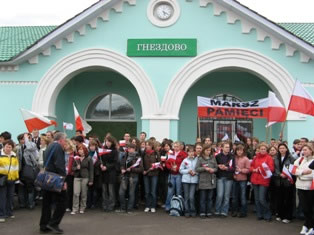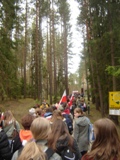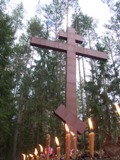OUR DESCENDANTS WILL REMEMBER.
It is early afternoon on 28 April 2007, when a group of almost 300 school students from Poznan and Smolensk leaves Gniezdowo Railway Station, heading for the Katyn Forest. Two students with a huge white-and-red banner 'A Memorial March' open the column. They are followed by uniformed cadets of the Smolensk military school marching in pairs. Behind them, carrying their national flags, walk young people from Poland and Russia. The students from Poznan additionally hold a flag with their city coat of arms. Everyone shares the same feeling, the feeling of experiencing something extraordinary and important.
We all walk up to the Memorial, where we are awaited by: the Deputy Governor of the Smolensk District Jurij Synkin, the Director of the National Memorial Complex 'Katyn Anatolij Wolosienkow and a huge group of representatives of the Russian Association of The People Repressed from its Smolensk division. Having entered the Memorial gate we turn towards the Polish War Cemetery welcomed with the toll of the underground Katyn bell. The historical meeting opens with the introduction by Karol Seifert, the VI LO Headteacher, who explicitly declares: 'Katyn is a symbol of both Polish and Russian tragedy since here the NKVD oppressors murdered thousands of citizens of both nations. It is also a symbol of lie and deception, as the Russians were convinced that their murdered compatriots were criminals and spies while the Poles were persuaded that the crime on the officers had been committed by the Fascists.

Then comes the culmination moment; the Polish and the Russian students listen to speeches by the Deputy Governor Jurij Synkin and Anatolij Wolosienkow, both advocates of the Katyn cause. In his words, the representative of the federal authorities considers the most important thing as follows: 'Here, in Katyn, meet our youngsters and children. Our Memorial March has been initiated with hope that our nations will live in harmony and, having the knowledge of history and remembering what the totalitarian regime had done, will do anything for such things never to happen again'.
Anatolij Wolosienkow, the Director of the Memorial, among other things says: '70 years ago Polish and Russian citizens were brought here by force. You came, riding and walking the same road, but you did it on your own will. Unfortunately, not all problems concerning the memory and truth or revealing the truth have yet been solved. I cannot also admit that we  , the older generation, have solved them all for you and we can hand Poland and Russia down to you without all those difficult matters'.
, the older generation, have solved them all for you and we can hand Poland and Russia down to you without all those difficult matters'.
The most moving, most deeply touching is the speech of Lidia Turczynkowa from the Russian Association of The People Repressed, who says: 'When our parents were brought to Katyn we were children, just like you, young people standing here. Now we are old. We want people never to forget the terrible lawlessness that ruled our country for so many years. We must join our forces, together the Poles and the Russians, to unable our authorities to commit such terrible crimes again. We will never become indifferent towards this problem because the graves of our parents are here. I want to thank the Polish part for organizing this March due to which we can all participate in the most important, the most sacred of meetings, the meeting of friendship. May all of us remember that the life of a nation is like a boomerang; if our authorities do something wrong, the next generation will have to pay for it all through its life. We have got the same graves and nothing unites people more than common misfortune.'
The Polish part is represented by Wincenty Dowojna, the Chairman of the MEMORAMUS Society from Poznan and a son of a murdered officer, who says: 'This trip has fulfilled a dream of hundreds citizens of Wielkopolska who had lost their relatives in the East.' Later he adds: ' My eyes were full of tears seeing all those young Poznan students, in contemplation lighting candles on the graves of the murdered Poles.' Andrzej Tomczak, the Director of the Poznan City Council Education Department, on behalf of the City Mayor of Poznan declares : 'The future built on truth lasts longest.'
All the speeches ( translated into Polish and Russian), the atmosphere and the awareness of the place make great impression on both the younger and the older. The emotion that lumps our throats makes singing 'The Dabrowski's Mazurka' hardly possible. The Ru  ssian cadets lay flowers in front of the altar.
ssian cadets lay flowers in front of the altar.
After the moment of contemplation, the I Memorial March moves off to the Russian part of the Katyn forest. There are no apparent graves there; the whole forest is a grave so we have to walk on the air footpaths that hang above the place. When we come to the prayer site at the Orthodox cross, we light long, thin candles then the Orthodox priest begins to sing. After the service we stick the candles into the ground that covers the bodies of about ten thousand murdered Russians. The ceremony ends with an unusual task to be performed by the Polish students: each of them receives a card with name and surname of a murdered person from Wielkopolska and has to light a candle and stick a white-and-red flag on the person's grave. Among the victims there is a woman, Janina Lewandowska, a pilot and a graduate of II LO in Poznan. Finding the inscription plates with names of all those dead: teachers, doctors, foresters, officials, lawyers is a very personal experience for the young people; each of them can stay alone with his/her reflections and prayers among the Katyn pines.
The day ends with a common bonfire at a remote forest clearing where the Polish and Russian students easily get together (they speak Polish or English), they exchange e-mail addresses, they take commemorative photos.
HISTORICAL NOTE
RELATIONS
II Memorial March- gallery
III Memorial March- gallery
 Home page
Home page MSP
MSP